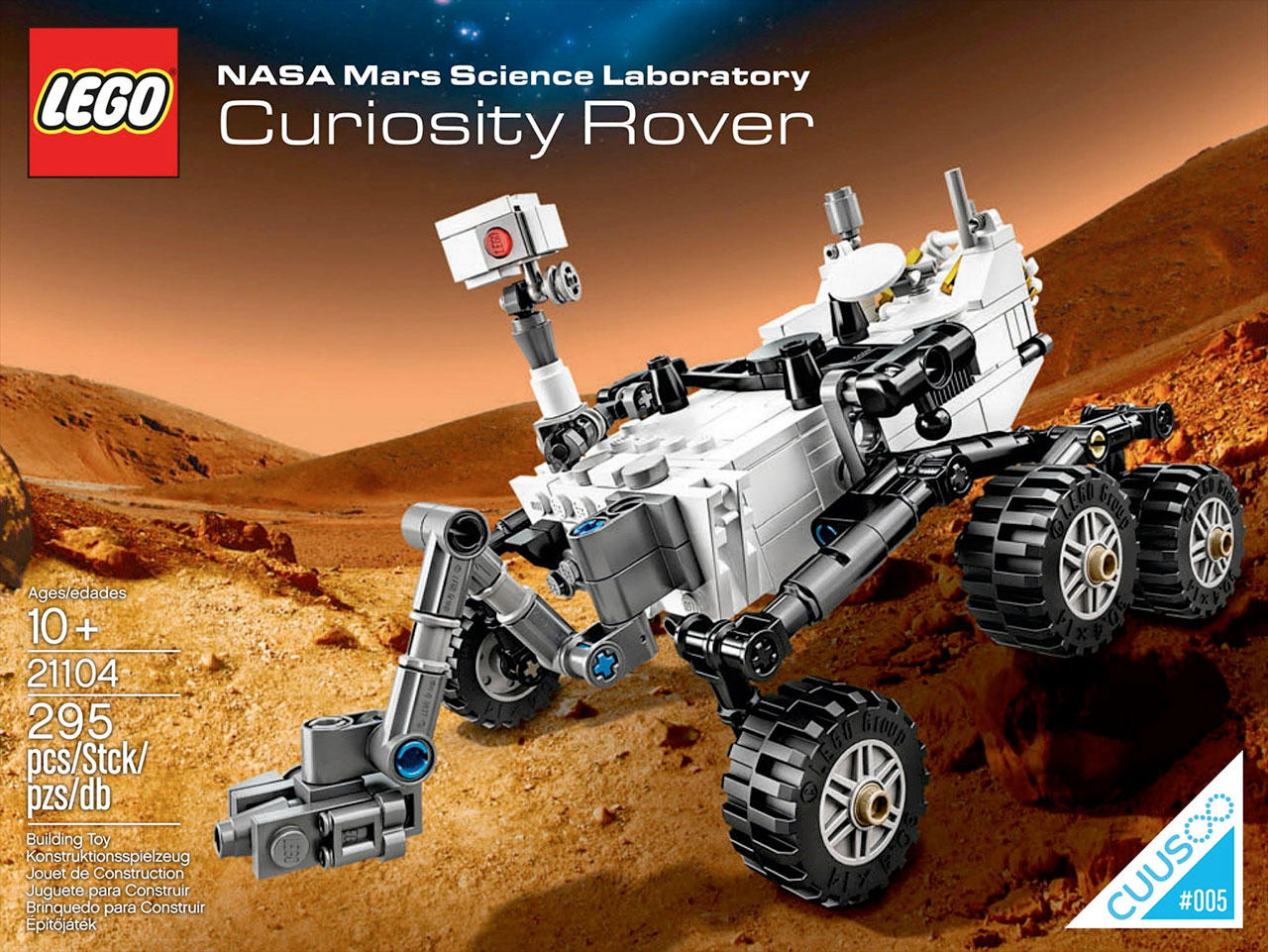LEGO is one of the few popular brands of toys you will commonly see in educational stores and museum gift shops. They encourage wholesome fun and creativity, and many have sciencey themes, mostly in the form of spaceships. Although these are usually fictionalized depictions of ships, there have been several occasions when LEGO has produced sets that are based on real, historic spacecraft.
The first ones were rather plain looking by today’s standards. In 2003 LEGO, collaborated with the Discovery Channel to produce six different sets based on actual spacecraft. Among them was their first minifig-scale Lunar Lander. These sets saw limited retail availability, mainly in gift shops and Discovery stores. LEGO would not reach more widely into the untapped market for accurate space sets until the LEGO builders community was asked for their own ideas.

In 2008, The LEGO Group launched a platform for those builders to submit their own concepts for official LEGO sets, originally called Cuusoo (Japanese for “imagination”), later renamed to LEGO Ideas. Three of the first five submissions that actually went into production were based on real scientific vehicles. The first was a submarine, the Shunkai 6500, and the others were for space exploration — The Hayabusa spacecraft that studied asteroids, and the Mars Science Lab Curiosity Rover. Other real world space sets would eventually emerge, most of which were good sellers.
Then, in 2019, the company celebrated the 50th anniversary of the moon landing, by introducing the LEGO Creator Series NASA Apollo 11 Lunar Lander, with a base and two minifig astronauts. Containing 1,087 pieces, it’s a far more detailed model than what they produced in 2003.
Here is a chart of all the historically accurate space sets released so far:
| Year | Series | Set No. | Name of Set | Description | No. of Pieces |
| 2003 | Discovery Channel | 7467 | International Space Station | A microscale model of the ISS, with microscale space shuttle. | 162 |
| 2003 | Discovery Channel | 7468 | Saturn V Moon Mission | Four models of vehicles from the Saturn V program, at different incompatible scales. | 178 |
| 2003 | Discovery Channel | 7469 | Mission to Mars | Four models used to send rovers to Mars, including a Delta II rocket; each at different scales. | 417 |
| 2003 | Discovery Channel | 7470 | Space Shuttle Discovery | A largely accurate space shuttle, with a Hubble telescope payload. It is smaller than minifig scale. | 826 |
| 2003 | Discovery Channel | 747 | Mars Exploration Rover | A Technic-based model of a NASA Mars rover. | 858 |
| 2003 | Discovery Channel | 10029 | Lunar Lander | A minifigure scale model of the Apollo Lunar Lander, with 2 minifig astronauts. Very basic detailing compared to the later set. | 467 |
| 2012 | LEGO Ideas (Cuusoo) | 21101 (Ideas #2) | Hayabusa | The first spacecraft to make physical contact with an asteroid in space. | 369 |
| 2014 | LEGO Ideas (Cuusoo) | 21104 (Ideas #5) | Mars Science Laboratory Curiosity Rover | A brick-and-Technic-based model of the MSL rover. | 295 |
| 2017 | LEGO Ideas | 21309 (Ideas #17) | NASA Apollo Saturn V | The Saturn V rocket with scale models of the command module, lander, and micro-scale astronauts. | 1969 |
| 2017 | LEGO Ideas | 21312 (Ideas #19) | Women of NASA | Minifig models of 4 famous women who had worked for NASA. | 231 |
| 2019 | LEGO Creator | 10266 | NASA Apollo 11 Lunar Lander | A minifigure scale model of the Apollo Lunar Lander, with 2 minifig astronauts. Much more detailed than the previous set. | 1087 |
More recently, a LEGO Ideas project for a new International Space Station set has won a “Fan Favorite” award, but as of this writing, it hasn’t been officially produced yet.
Some of the best
The Mars Science Laboratory Curiosity Rover (21104)


This has a brick-based body, with Technic-based wheels for realistic suspension. I like it because it’s actually more detailed than some of the similarly-sized, specially molded models of the rover. Designed by a mechanical engineer who actually worked on the real Curiosity.

This set isn’t based on any historic people, but it deserves a shout-out as a popular, science-related set. It includes three generic female scientists, one of whom is an astronomer. It was the eighth LEGO Ideas set produced.


This was probably the most complicated and “difficult” LEGO model I’ve ever built. It actually has a double-hull design that can be somewhat delicate while in the midst of building, but the end results are fantastic, and very sturdy!
The rocket actually comes apart into three stages, and includes appropriately scaled miniature models of the command module and lunar lander that can fit inside of it, along with three micro-scale astronauts (actually four, if you include the spare). It even has pieces to display the command module after it had splashed down into the ocean. A very complete set for re-creating your own Moon landing story!
The Saturn V comes with 1,969 pieces, which happens to be the year of the first Moon landing.

Note that the helmet stand in this photo, behind Mae Jemison, is not part of the building instructions. It was assembled with extra pieces that came with the set.
Includes vignettes of four famous women who worked at NASA:
- Margaret Hamilton, the Apollo computer programmer. This one recreates a photo of her standing next to the stack of books containing her code, complete with a coat rack in the background.
- Mae Jemison, the first black woman in space. She shares a platform with:
- Sally Ride, the first American woman in space. This platform also contains a miniature model of a space shuttle with its booster rockets.
- Nancy G. Roman, the “Mother of Hubble”, with a model of the Hubble Space Telescope, and a diagram of the Cone Nebula.
NASA Apollo 11 Lunar Lander (10266)


This minifig-scale model is so detailed, you can even take it apart to see its interior and the fuel canisters of its descent stage! It also includes a model of the laser reflector device, a camera used for filming the landing, a base decorated to look like the Moon’s surface (complete with footprints), and the obligatory American flag.
The future can be up to you!
This probably won’t be the last we’ll see of historically accurate LEGO space sets. That future can, in part, be up to you! A lot of the company’s drive to produce these sets came from ideas in the LEGO building community. If you want to fill a gap in space history, or ANY subject really (though we like science the best), why not build it yourself, and then submit it to the LEGO Ideas web site!
All unboxed photos from Mitchell Lampert’s personal collection.
AIPT Science is co-presented by AIPT and the New York City Skeptics.
Join the AIPT Patreon
Want to take our relationship to the next level? Become a patron today to gain access to exclusive perks, such as:
- ❌ Remove all ads on the website
- 💬 Join our Discord community, where we chat about the latest news and releases from everything we cover on AIPT
- 📗 Access to our monthly book club
- 📦 Get a physical trade paperback shipped to you every month
- 💥 And more!













You must be logged in to post a comment.